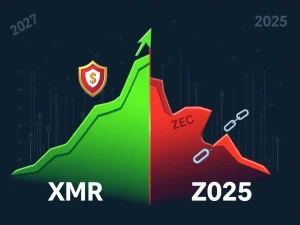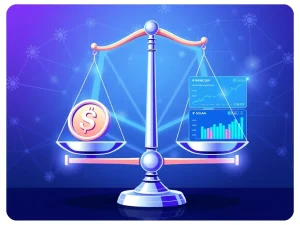Web3 Banking Takes a Leap: Trump-Backed WLFI and Vaulta Forge a Transformative Alliance

In a move set to redefine the landscape of digital finance, a significant announcement has emerged from the intersection of traditional influence and cutting-edge technology. World Liberty Financial (WLFI), a blockchain initiative with ties to former U.S. President Donald Trump, has partnered with Vaulta, the rebranded EOS Foundation. This alliance aims to construct a robust and regulatory-compliant Web3 banking infrastructure within the United States. For anyone tracking the evolution of cryptocurrency and its integration into mainstream finance, this development is nothing short of pivotal. It signals a serious intent to bridge the gap between the established financial world and the burgeoning decentralized economy, offering a glimpse into how digital assets might soon be used for everyday transactions.
Understanding the Transformative Web3 Banking Alliance
The collaboration between WLFI and Vaulta isn’t just another crypto partnership; it’s a strategic maneuver designed to usher in a new era of compliant decentralized finance. At its core, the alliance seeks to integrate WLFI’s USD1 stablecoin into Vaulta’s advanced blockchain-based platform. This positions the combined entity as a compliant solution for decentralized finance (DeFi) applications and seamless cross-border transactions.
- WLFI’s Evolution: Originally, WLFI might have been perceived as having an ideological bent due to its political connections. However, this partnership clearly marks a significant shift towards becoming an infrastructure-driven DeFi player. Their focus is now on building tangible, usable financial rails.
- Vaulta’s Rebranding: Formerly known as the EOS Foundation, Vaulta’s transformation into a “banking operating system” underscores its ambition. The rebrand signifies a pivot towards institutional-grade services, emphasizing high-speed settlements and robust cross-chain interoperability, essential features for a modern financial system.
- The Core Offering: The combined platform aims to enable users to conduct on-chain dollar transactions without relying on traditional intermediaries, all while adhering to U.S. financial regulations. This is a game-changer for accessibility and efficiency in digital payments.
WLFI and Vaulta: A Strategic Pivot for DeFi
The formalization of this partnership via a July 23 press release highlights WLFI’s commitment to regulatory alignment. Their USD1 stablecoin is notably backed by U.S. Treasuries and cash equivalents, a crucial detail that differentiates it from less regulated digital assets. This backing provides a layer of stability and trust, which is paramount for institutional adoption.
Zak Folkman, co-founder of WLFI, articulated the alliance’s vision, stating their aim is to “build the connective tissue between traditional finance and DeFi.” This ‘connective tissue’ is vital for ensuring that both retail users, who are increasingly interested in crypto, and large institutions, who demand security and compliance, can access and utilize decentralized financial tools. Vaulta’s role is to integrate USD1 into its digital banking framework, creating a seamless user experience for on-chain dollar transactions.
Vaulta’s strategic rebranding from the EOS Foundation reflects its dedication to institutional-grade services. Their renewed focus on real-world asset tokenization and cross-border payment solutions aligns perfectly with the growing demand for more efficient and transparent financial instruments in the global economy. This pivot by Vaulta is a clear indicator of the maturity and evolving landscape of blockchain technology, moving beyond speculative assets to practical, real-world applications.
The Role of the USD1 Stablecoin in Compliant Transactions
The centerpiece of this alliance is the stablecoin, USD1. Unlike many other stablecoins that have faced scrutiny over their reserves, WLFI’s USD1 aims to stand out by being explicitly backed by U.S. Treasuries and cash equivalents. This commitment to transparency and robust backing is critical for fostering trust, especially among risk-averse institutions and traditional financial players considering entry into the digital asset space.
Why is this significant? A truly compliant and well-backed stablecoin can serve as a reliable digital dollar, facilitating:
- Faster Settlements: Traditional banking often involves delays, especially for cross-border transactions. Stablecoins on a blockchain can settle transactions in near real-time.
- Reduced Costs: Eliminating intermediaries and leveraging blockchain efficiency can significantly lower transaction fees.
- Enhanced Transparency: On-chain transactions offer a level of auditability and transparency that traditional systems often lack.
- Broader Accessibility: Digital dollars can reach underserved populations and enable new financial services models globally.
WLFI’s recent strategic financial moves further underscore their commitment. The company purchased 3,400 ETH (approximately $13 million) to expand its $275 million Ethereum reserve, signaling an aggressive treasury diversification strategy. Furthermore, governance token holders have approved a proposal to make the WLFI token tradable within weeks, further embedding the project into the broader crypto market ecosystem.
Navigating the Regulatory Landscape: Challenges and Opportunities
The alliance between WLFI and Vaulta is not operating in a vacuum. It aligns with broader industry trends, including major financial institutions like Citigroup exploring stablecoin issuance. Legislative efforts, such as the GENIUS Act in the U.S., also seek to establish a federal framework for stablecoins. These developments highlight a growing institutional appetite for blockchain-based financial tools, driven by the demand for faster, lower-cost transactions and, crucially, regulatory clarity.
However, the path forward is not without its challenges. The company’s 60% ownership by Trump’s family has drawn scrutiny from critics, who raise concerns about potential conflicts of interest or even foreign influence over U.S. policy. Despite this, WLFI maintains that USD1’s compliance-focused approach distinguishes it from unregulated stablecoins, positioning it as a secure alternative for institutions wary of regulatory risks.
The success of this alliance will largely depend on its ability to skillfully navigate complex regulatory environments while simultaneously maintaining technical scalability. Vaulta’s infrastructure is designed to support enterprise-grade DeFi applications and near-instant settlements, but challenges remain in achieving seamless interoperability with legacy financial systems. On the other hand, WLFI’s political connections, while drawing scrutiny, may also provide a unique competitive edge in a market where trust and regulatory approval are paramount. As U.S. and global regulators continue to refine stablecoin policies, the WLFI and Vaulta collaboration exemplifies the increasing convergence of politics, technology, and finance in the Web3 era.
While this partnership is still in its nascent stages, it strategically positions both firms to compete with established traditional banks and innovative fintech players looking to leverage blockchain innovation. The ultimate outcome will likely hinge on several factors: the evolving regulatory landscape, the rate of market adoption for compliant digital assets, and the alliance’s ability to balance groundbreaking innovation with unwavering compliance.
Frequently Asked Questions (FAQs)
Q1: What is the primary goal of the WLFI and Vaulta alliance?
The primary goal is to establish a regulatory-compliant Web3 banking infrastructure in the United States, integrating WLFI’s USD1 stablecoin into Vaulta’s platform to facilitate decentralized finance (DeFi) and cross-border transactions.
Q2: How is WLFI’s USD1 stablecoin different from others?
WLFI’s USD1 stablecoin is designed to be regulatory-compliant and is backed by U.S. Treasuries and cash equivalents, aiming to provide a secure and stable digital dollar for both retail and institutional users.
Q3: What was Vaulta known as before this partnership?
Vaulta was previously known as the EOS Foundation. Its rebranding signifies a strategic pivot towards institutional-grade services and becoming a ‘banking operating system’ with a focus on high-speed settlements and cross-chain interoperability.
Q4: What are the potential benefits of this Web3 banking alliance?
The alliance aims to offer faster, lower-cost, and more transparent on-chain dollar transactions without traditional intermediaries. It seeks to build ‘connective tissue’ between traditional finance and DeFi, making digital finance more accessible and compliant.
Q5: Are there any concerns regarding WLFI’s political connections?
Yes, WLFI’s 60% ownership by Donald Trump’s family has drawn scrutiny, with critics raising concerns about potential conflicts of interest or foreign influence. However, WLFI emphasizes its compliance-focused approach to distinguish USD1 from unregulated stablecoins.









